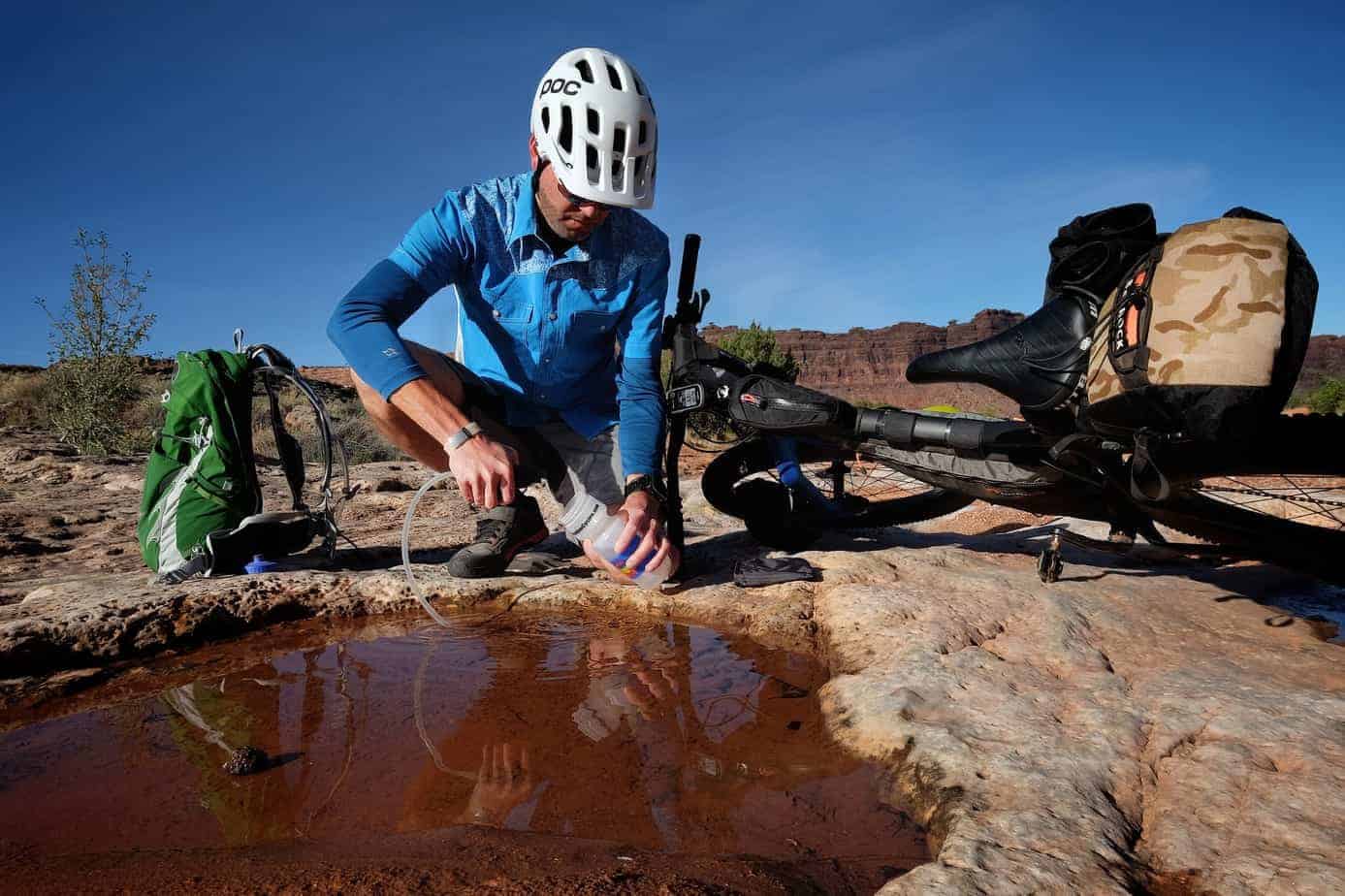All travelers understand the importance of clean drinking water, but too few know how to best select the proper water treatment system for their individual needs. It is an understandable conundrum as there are seemingly endless options for filters, purifiers, and chemical solutions. Over the span of the last two years, I set out to evaluate nearly two dozen of the leading water treatment products to see how they stack up.
This roundup, as extensive as I could make it, includes the latest products as well as old favorites. I tried to fit in everything from iodine tablets to high-volume pumps, and treated all types of water from murky goo in cow ponds to questionable water supplies in undeveloped corners of Asia. Which one is best is a question with no definitive answer and depends entirely on the situation in which it is used.
The author’s disclaimer: This roundup does not include every system on the market, but it’s pretty close. Before you dog pile the comment box, just know this is not my life’s work, but I did dedicate a significant chunk of it to this project. That included flying around the country to speak face to face with some of the leading water treatment scientists in the industry. It is however, just one man’s humble review.
Why bother, and the bad bugs to avoid
There is an extensive list of pathogens travelers need to avoid, but the most common are a particular group of bacterium, protozoan cysts, and viruses. Backcountry travelers should be most concerned with giardia, cryptosporidium, and e coli. The viruses to keep at bay are norovirus, rotavirus, and on a more worldwide basis, hepatitis A. We’re fortunate to not need to worry much about viruses in North America as those pathogens are usually only present where infected human waste is present in the water. It’s easy to get spooked by viruses, and they are worthy of concern, but as an example, you’re far more likely to contract norovirus on a cruise ship (very common) than you are from a mountain stream, even one teaming with other nasty pathogens. It’s also worth pointing out that many people who think they got sick from water probably made themselves ill due to poor camp hygiene. Wash your hands, people.
Filters and purifiers
These two designations are frequently misused or erroneously interchanged. In the most technical definition, purifiers meet strict EPA standards for the safe neutralization of harmful pathogens, including viruses. Filters, also referred to as microfilters, physically remove particulates and pathogens via a mechanical process and can also be effective enough to qualify as a purifier. However, a filter can be a purifier, but not always. A purifier may not filter at all. In recent years UV lights have been used to purify water in much the same way chemicals have been used, but they do not remove anything from the water. The same goes for boiling, a process my backpacker dad used to call, “Dead bug and dirt soup.”
Selecting a water treatment system
The first thing any consumer should do when selecting a water treatment product sold under the classification of a water purifier is ensure it has been tested and meets EPA and/or National Sanitation Foundation (NSF) standards. There’s no need to set up a lab, just read the label.
There is one unfortunate consideration when purchasing a filter. There are no government standards to certify the efficacy of a filter. The only consumer protections in place fall under the auspices of false advertising provisions. If a manufacturer claims their product will perform to a certain level of efficiency, it is up to someone else to prove them wrong. In light of that, consumers are advised to do their due diligence. Some manufacturers go the extra step to have their products tested by third-party organizations, even the U.S. Military, which has very strict and well-defined criteria to establish efficacy on multiple levels.
It is most important to understand that different products have been designed for different applications. A filter best suited for solo use in an emergency won’t be of any use to a group of six people on a month-long backwoods trip. Pairing a product’s intended use to your own needs is critical. To take it a step further, I scrutinize how user friendly some systems are, if they can be field serviced, how they work with certain types of water resources, and lastly, the cost to operate.
A word about hollow fiber filter technology: You’ll see numerous systems using hollow fiber filter technology, but you need to be aware not all of these products are the same. A number of manufacturers produce hollow fiber filters, some as tiny as a cigar, others as large as a VW Beetle. There are even differences in material and manufacturing processes, so don’t assume everything with a hollow fiber filter is the same.
Potable Aqua, $8

I don’t want to burn too many words on this product. I think it’s gross and try never to use it unless forced to because the active ingredient is iodine. Effective against nearly all waterborne pathogens including viruses, it doesn’t work against cryptosporidium, thanks to the thick candy shell that little bug has. Iodine also requires 30 minutes to activate and many people demonstrate adverse effects to it beyond the foul taste, which always makes me gag. One last ding, it’s not healthy to consume regularly. A better alternative is Potable Aqua’s own chlorine dioxide product.
Best attributes: Not sure it has any. It is dirt cheap.
Ideal application: Emergency use.
Aquamira Drops, $15 (Best emergency backup)
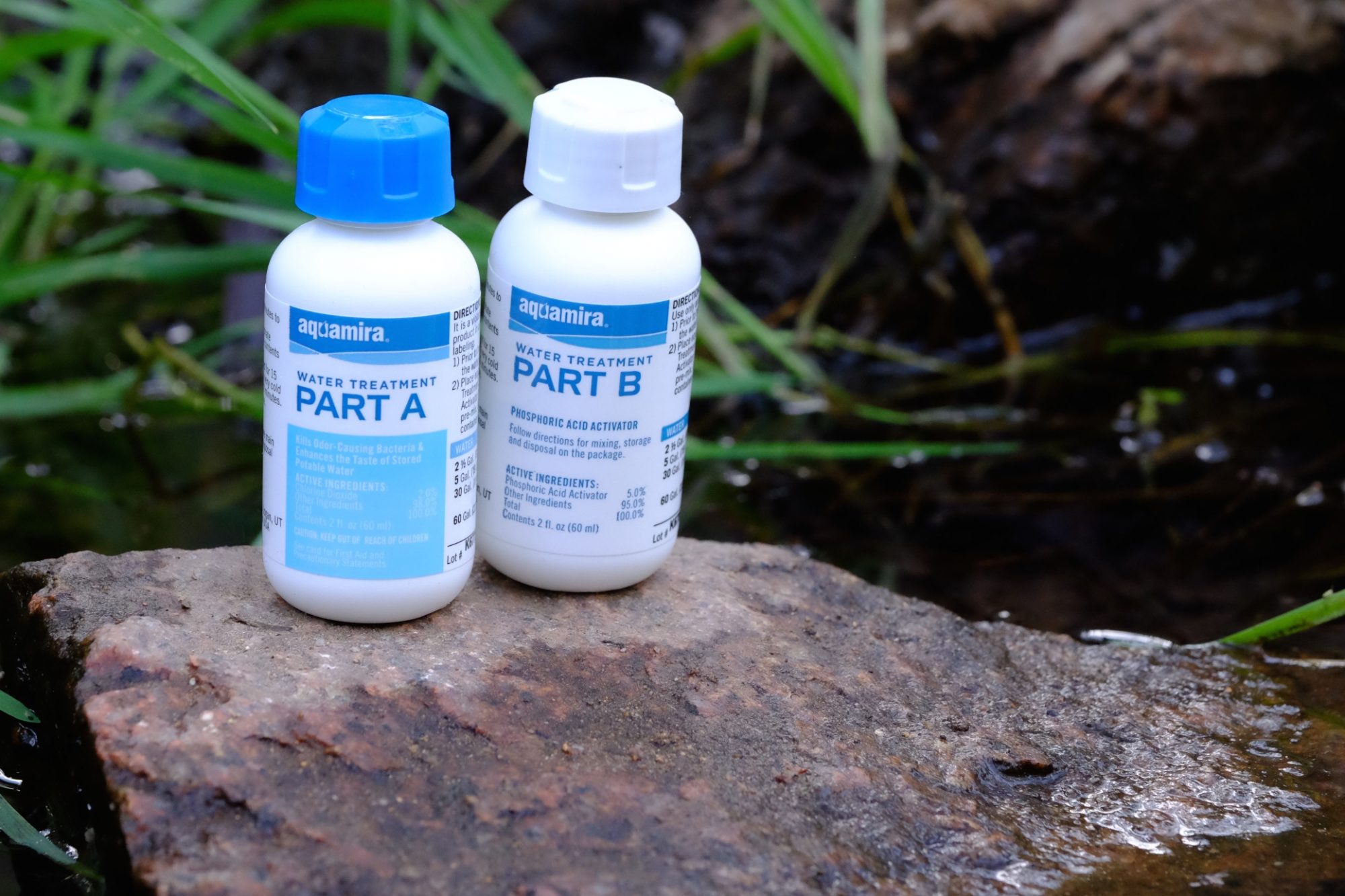
Aquamira is EPA-approved chlorine dioxide in a highly concentrated two-component formula. Unlike iodine it can neutralize cryptosporidium. Some people say it makes water taste better, but I’m not going to support that claim. Although quicker to use than Potable Aqua, when adding Aquamira solution to cold water, it is necessary to let it sit for 15-30 minutes. That extra dwell time is what makes it effective against cryptosporidium. Many people carry Aquamira as a backup to their usual filtration systems. You have to calculate a little math in your noggin to treat larger volumes of water to get the dosing right, but it is easy to use and pretty cheap. A one ounce supply of Aquamira treats 30 gallons of water. www.aquamira.com
Best attributes: Cheap to use, reliable and a great backup plan.
Ideal application: Emergency use, lightweight travel, backup to pump.
Tester’s Notes: I don’t dislike this product, and have used it extensively, but I prefer not to use it. The taste bothers me. I do like using it to treat water I might use for cleaning purposes. I often use it to treat a large container of water for washing dishes and faces.
LifeStraw, $20
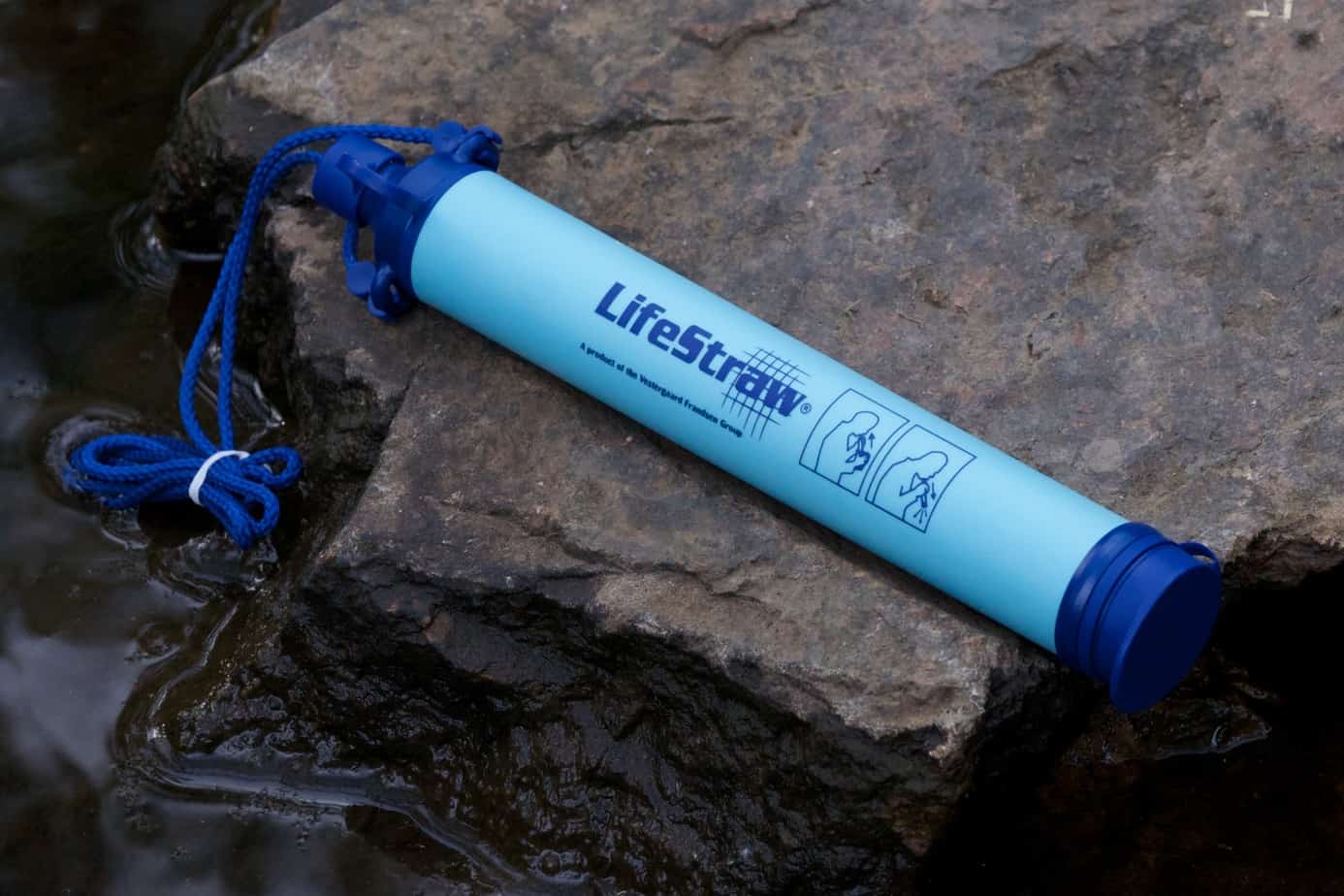
There’s not much to the Lifestraw, and that is why it’s so great. Dip one end of the straw in dirty water and start drinking through the mouthpiece. The 0.2-micron hollow-fiber filter element removes everything but viruses and even has an activated charcoal capsule to remove organic contaminants and pesticides. Here in the desert southwest, dead leaves in small ponds can impart a terrible flavor the LifeStraw mitigates, if just slightly. The replaceable filter can process up to 1,000 liters, but there is one downside—you can’t process water into a separate container. It’s only good for delivering clean water directly to your mouth. That creates inherent limitations as you can’t collect water for portage or cooking.
The other compelling reason to buy a Lifewstraw, or any of the other filtrations systems sold under that name, is the philanthropic foundation behind the brand. This is not a company shilling products for a fat bottom line. Lifestraw is first and foremost an organization dedicated to providing those in need with clean drinking water. In that capacity, Lifestraw has almost eradicated the devastating Guinea worm in Africa. That’s an impressive accomplishment. www.lifestraw.com
Best attributes: Simple operation, superb quality, fantastic story behind the LifeStraw brand.
Ideal application: Emergency use, international travel, backup to pump.
SteriPen Quantum Rapid Purification System, $70

SteriPen’s products have invited some disagreement within the Overland International team. Roughly six years ago we funded an elaborate and costly lab test which included a SteriPen—and we flunked it. For myself and our esteemed Editor in Chief, Chris Collard, those results did not sit well. Aside from the dozens of third party tests and water treatment experts to confirm the validity of UV technology, the pair of us had conducted our own tests by drinking untold gallons of SteriPen-treated water on five continents spanning a dozen countries—and with no ill effects.
For the traveler, the SteriPen has unrivaled benefits, portability and ease of use chief among them. It’s just as easy to treat a glass of water at a cafe in Mombassa as it is a bottle of water in a mountain stream. It’s quick, push-button simple, and has the advantage of disinfecting all microbes including viruses. If there is a downside, it is the inability to remove sediment or process large volumes of water with any speed. The latter issue has been addressed with SteriPen’s new Quantum Rapid system which can now treat four liters of water in just 150 seconds. Using their proprietary reservoir to optimize UV light transmission through the water, the Quantum Rapid is possibly the fastest purifier on the market.
The combination of the AA-powered SteriPen and the new Quantum Rapid reservoir increases the utility of the UV light, making it ideal for international travel and at least some backcountry uses where water turbidity is less of an issue. www.steripen.com
Best Attribute: Speed of use. Compact size and efficacy against viruses.
Ideal Application: Personal use for international travel or backcountry use where water runs clear and is already palatable to drink even if it is biologically unsafe.
Additional tester notes: I have used the SteriPen in some truly sketchy parts of the world and consumed water I know would have made me ill had I not nuked it with UV light. I’m an ardent fan of this technology, but also know it’s easy to contaminate your clean water if you’re sloppy. You have to fully understand how this system works to not goof it up. One side note though, the Quantum reservoir feels a bit on the cheap side. The o-ring in the large lid continues to fall out and is waiting to get lost.
SteriPen Adventure Opti, $90 (Best for international travel)

The unit pictured is the previous generation pen not using LED “opti” technology. It has served me well on countless outings.
This unit is almost identical to the one listed above with the main exception of the power source and overall size of the unit. The Adventure Opti uses CR123 batteries instead of AA batteries, which makes it 25% smaller and obviously lighter. Both do the trick, but I often prefer the Adventure Opti for the size. Just be sure to pack extra CR123 batteries as you’re not going to find those in Bangladesh if you run out.
MSR TrailShot, $50 (Best light and fast personal filter)
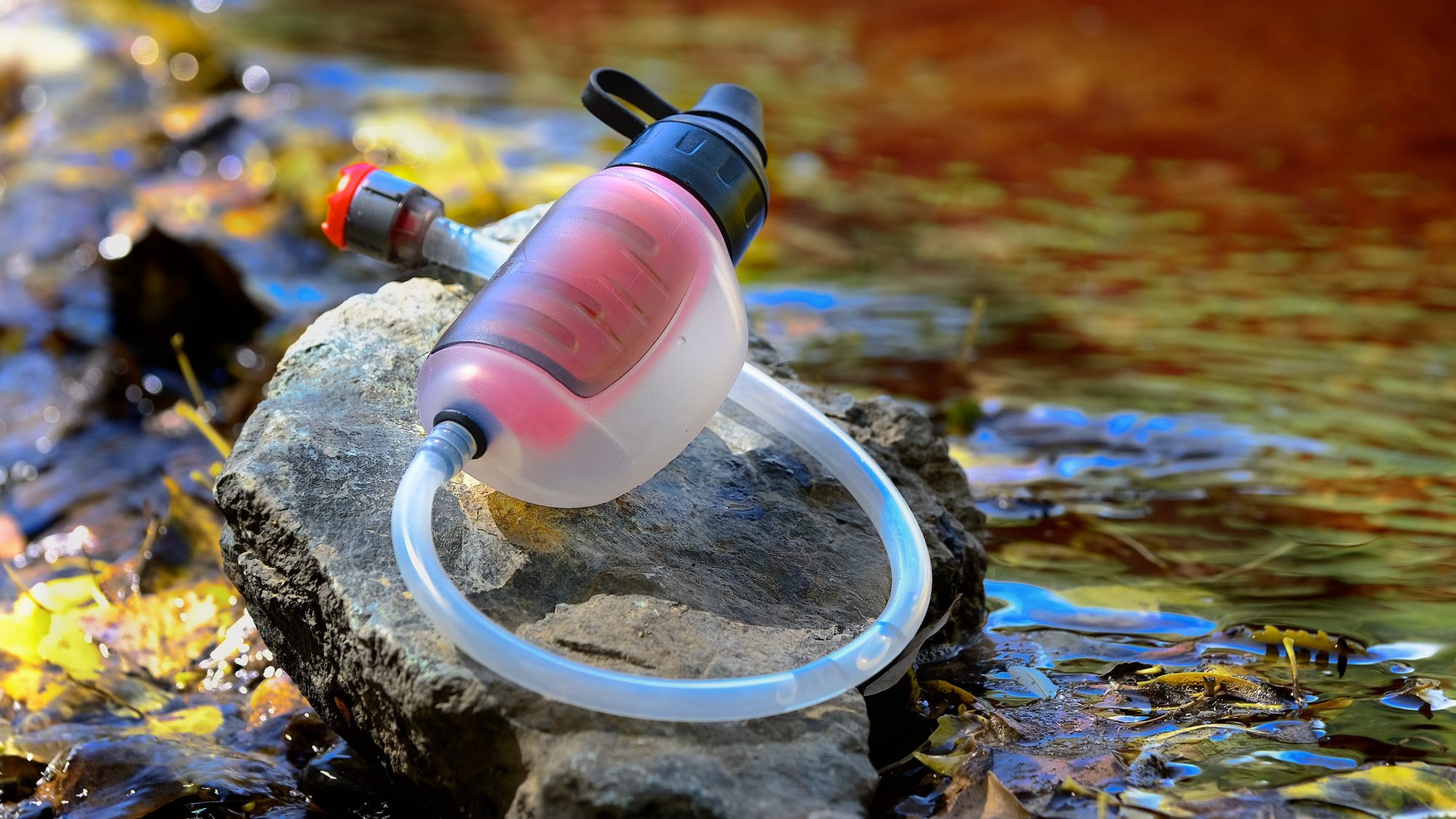
This product (pictured in the lead image) just hit dealers this winter and has already taken the market by storm. Unlike the LifeStraw, the TrailShot’s built-in silicone pump allows it to be used as a drink-direct filter or employed to filter water into a secondary container. Simply dip the hose in a water source, give the silicone bulb a few squeezes, and either drink from the mouthpiece or fill a bottle. It filters down to 0.2 microns at a swift one liter per minute flow rate.
The hollow-fiber filter element can remove all major waterborne bugs, save for viruses, and it does quite well to reduce particulates and even some unpleasant flavors. Each replaceable filter element can produce up to 2,000 liters and field cleaning only requires a few sturdy shakes. At just 5 ounces with an overall size that literally fits in a pocket, this is one of my favorite products of 2017. In situations where the SteriPen doesn’t fit my needs, specifically in places where water is more prone to sediment, I take the TrailShot. Read my full review here: Expedition Portal: Field Tested MSR TrailShot.
Best attributes: Small, fast, versatile, and cheap. The best ultra-light personal filter on the market.
Ideal application: Personal domestic backcountry use, hiking, mountain biking, etc.
Tester’s notes: On more than a few occasions I felt like I was clogging the filter, but it’s very easy to restore the pumping action with a handful of vigorous shakes. That usually restores a good flow rate.
Katadyn BeFree, $40 (Never leave home without it)
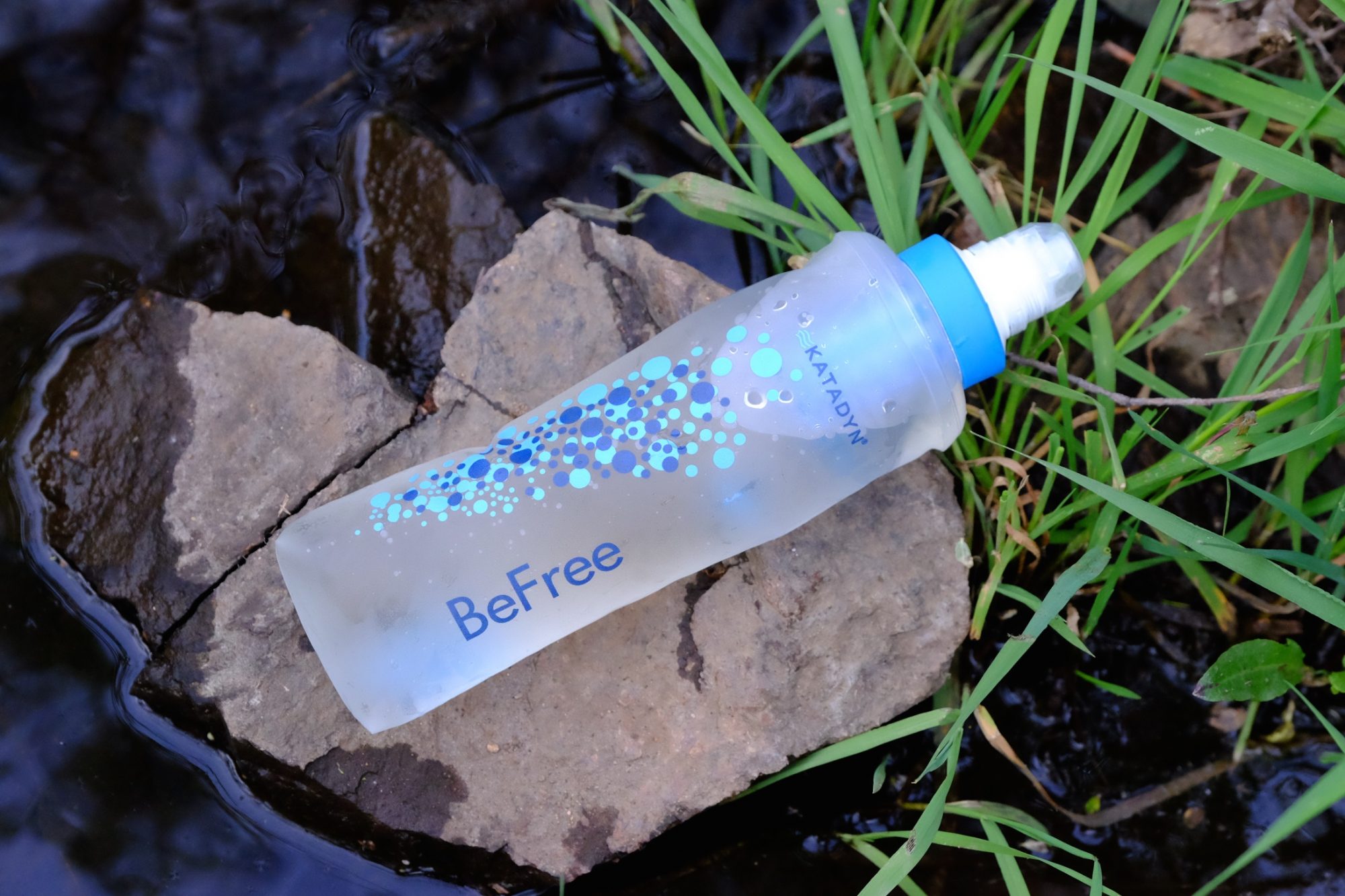
Bottle filters are all the rage these days and many of them do little more than make your water palatable. The BeFree does that as well, but packs a serious filtration punch capable of removing anything in the water down to .1 microns. That is sufficient to remove all concerns except viruses. The small hollow-fiber filter is threaded into the drink-through cap and the bottle is made of super flexible thermoplastic polyurethane, silicone, and HDPE by the soft-container gurus at Hydrapak. If it seems delicate, it’s not. Hydrapak’s reservoirs are incredibly tough. I like how the whole thing fits in a jacket pocket.
Using the BeFree is as simple as removing the lid, filling it with untreated water, then drinking through the top cap while giving the reservoir a light squeeze. It is a small bottle at roughly half a liter, but due to its low 2-ounce weight, makes for a great backup system or travel solution for personal use. I keep the BeFree in my daypack when on long hikes. For $40 it is also great value. www.katadyn.com
Best attributes: Convenient for travel and a good backup or emergency system.
Ideal application: Emergency use, domestic travel.
Katadyn Hiker Pro Microfilter, $85 (A proven favorite)
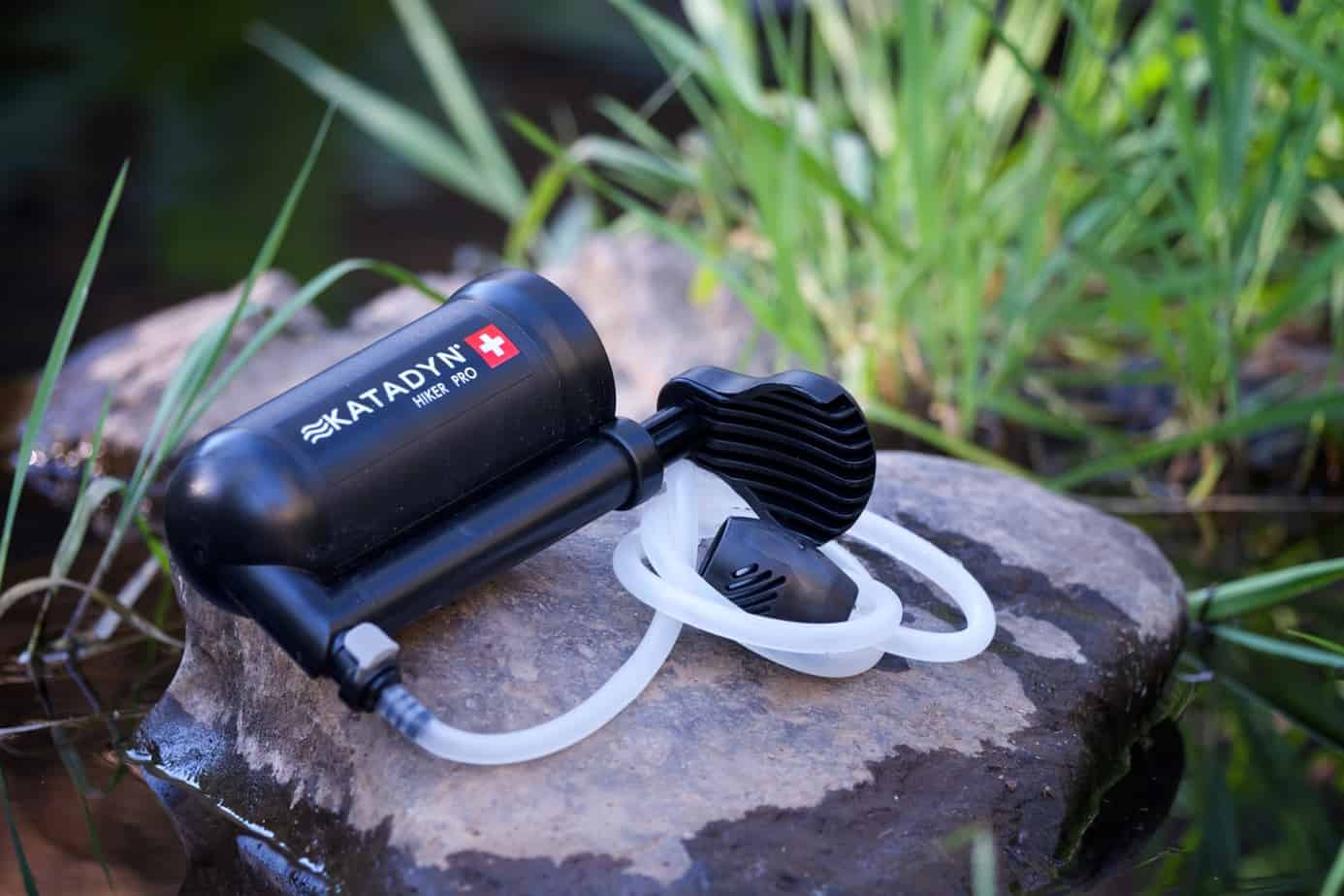
Many of you may recognize this filter because it has been around for ages. Some will remember it as a PUR product in its former life. I have owned and used it for over 20 years and trust it implicitly. What makes the Hiker Pro so unique is the pleated glass-fiber filter element. The pleats yield massive surface area which greatly reduces the potential to clog. Not to say it won’t jam up, but it takes a lot of sediment to do so, and cleaning it isn’t too difficult. A thin outer membrane shields the main filter from sediment and is quickly and easily rinsed to restore flow. Not the fastest pump, it still squirts out clean water at a little under a liter per minute. The advertised flow-rate is one liter per minute, but it’s usually just a touch slower.
Another advantage to the Hiker is its simplicity. The entire unit can be dismantled, cleaned, and returned to operation in just a few minutes and with no tools. The one moving part is easy to maintain making for a nearly infallible product. It won’t solve the virus issue, but this is a pump I would recommend time and again. www.katadyn.com
Best attributes: Great solution for murky water. Easy to maintain in the field. Cheap.
Ideal application: Personal or small group backcountry use where viruses are not a threat and water turbidity an issue.
Tester’s additional notes: If you fail to clean the filter when it starts to slow, you risk impregnating the glass-fiber filter with heavy sediment. Once that’s done, you’re out of luck. The more you baby the Hiker Pro, the better it will serve you.
MSR HyperFlow Microfilter, $100 (Fastest filter)
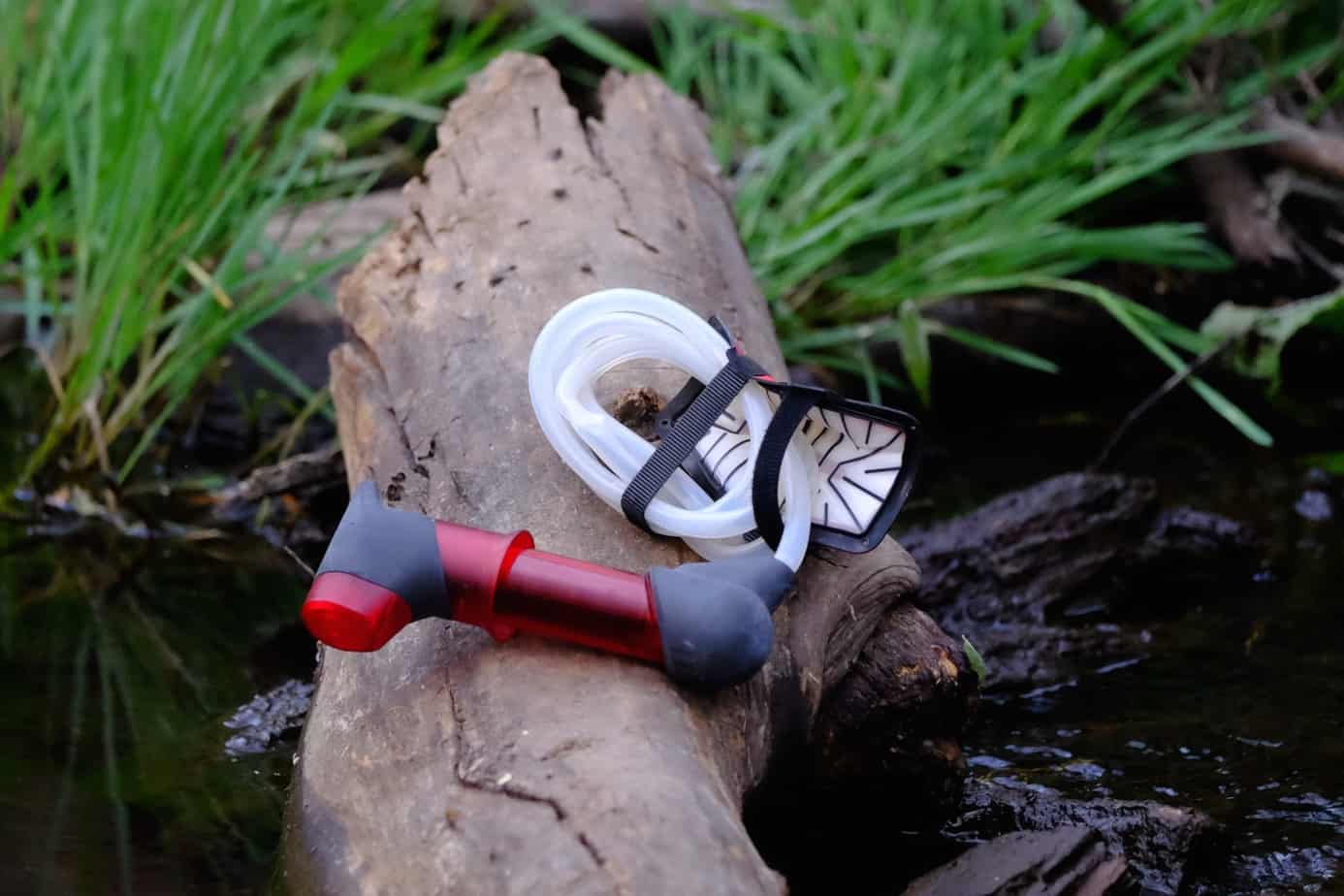
Inspired by a bicycle pump, the HyperFlow is a relatively new product for MSR. The first of their filters to use hollow-fiber technology, it lives up to its name with an impressive three liter per minute flow rate. Even better, each liter only requires 20 strokes. It’s also quite light at just 209 grams and packs into a compact bundle. I’ve been using the HyperFlow for nearly five years on my light and fast sorties and find the filter element does admirably well with slightly silty water—right up to the point it clogs.
The one major drawback with the HyperFlow is the process required to backflush the filter element. It involves dismantling the pump and repositioning two interval valves, then backflushing it with clean water. Overall it’s a bit of a production. For those reasons I try to avoid using it in the desert or places where silty water is inevitable. In the right conditions it is fast, easy, and compact. Not that I’d call it delicate, it probably isn’t the filter to issue to a ham-fisted boy scout. That’s perfect application for MSR’s MiniWorks EX. www.msrgear.com
Best attributes: Extremely fast. Small and light.
Ideal application: Personal or small group backcountry use where viruses are not a threat and water turbidity is not an issue. Best for people who need a light system with high flow rate.
Tester’s additional notes: I genuinely love this filter, but consider it a high-performance piece of equipment which demands TLC. Try to pump water out of a cow pond or silty desert river and you’ll be doing the backflush boogie all day long.
Katadyn Pocket, $370

The first thing many people notice about the Pocket is the price. Nearly four times more expensive than competing products it seems like a terrible value, but it’s actually worthy of the ask. Constructed of aluminum and stainless steel with silicone seals, the ceramic filter element has the capacity to process a whopping 50,000 liters and comes with a 20-year warranty. We often throw around the term expedition grade, but the Pocket genuinely earns that label. The plunger style pump keeps moving parts to a minimum and the rounded metal handle affords a secure and comfortable grip. Ceramic filter elements are lauded for their durability and although it’s slightly easy to clog, it can be cleaned in seconds and the one liter per minute flow rate restored in full.
Our team has used the Pocket on several extended trips where dependability was paramount. From the Wakhan Corridor of Tajikistan to the wilds of Alaska, the Pocket has proven reliable every time. For some travelers it won’t fit the bill as it can’t defend against viruses and it is rather heavy and large, but it is worthy of its legendary reputation. www.katadyn.com
Best attributes: 50,000 gallon capacity on a single filter, and the 20-year warranty.
Ideal application: Small- to medium-size groups on remote travels for extended periods of time. It’s not appropriate for backpacking due to the weight, and it doesn’t like being dropped, but it is otherwise a fantastic unit.
Tester’s Notes: As a backcountry guide I have processed thousands of liters through the Pocket. I trust it. I also think it has a few limitations. The weight is an issue and not everyone needs this level of equipment. As durable as the construction is, I’ve seen two Pocket filter elements broken with small drops. It isn’t indestructible. The largest drawback is the price.
MSR Guardian Purifier, $350 (Editor’s Choice)
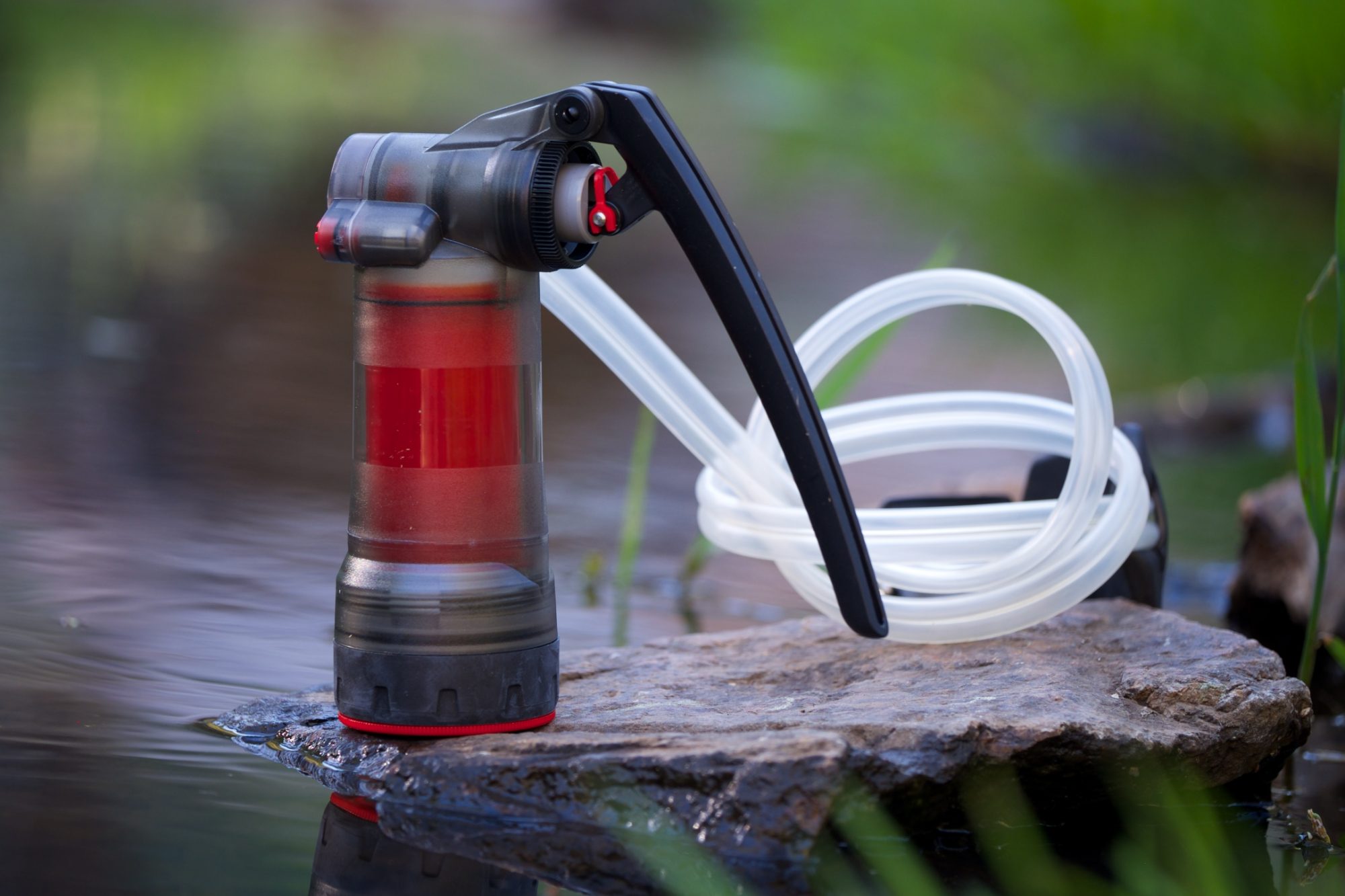
Released to the public just last year, MSR’s top purifier may have single handedly recalibrated our expectations of water treatment systems. It filters to such a small size it removes viruses and has passed the EPA’s Guide Standard for Microbiological Purifiers. It also passed the U.S. military’s NFS protocol P248 standard which confirmed it purifies water and eliminates sediment within their engineered “worst-case” scenarios. Imagine purifying murky swamp water with a high pH level. Toss in a little salinity, lots of goo, and that’s the military’s idea of “worst case water.” Bleh.
The Guardian has an impressive 2.5 liter per minute flow rate and the innovative design redirects a small portion of water within the unit to self clean the filter element with every pump stroke. That’s right, it cleans itself as you use it. It was built to survive freezing, a 6-foot drop onto concrete, and it’s easily field serviced in minutes with no tools. The hollow-fiber filter cartridge can process up to 10,000+ liters, and like other MSR pumps, can be connected directly to large mouth water bottles and MSR Dromedary bags. It is relatively light at 17.3 ounces, not too bulky, and for those of you for whom it matters, it’s made in the USA, as are the other MSR systems. www.msrgear.com
Best attributes: Purifies, self cleans, durable, high-capacity filter, fast flow rate
Ideal applications: Small to medium groups in any environment from backcountry use to international travel.
Tester’s additional notes: File this product under, “Best water purifier ever made,” and leave it at that. I could go on, but I truly believe this is the purifier standard by which all others will be measured for some time to come. I don’t just say that based on my extensive field testing, but after a visit to the MSR water lab, arguably the most advanced facility of its kind, I don’t think the Guardian has a peer.
MSR MiniWorks EX Microfilter, $90 (The Desert Hero)

The MiniWorks EX is one of the most respected and trusted filtration systems ever produced. Popular with backcountry travelers in the desert Southwest, it is the go-to for places where sediment is a major concern. In those settings, it’s not uncommon to have to clean any filter element with every other liter of water. The MiniWorks’ ceramic filter can be removed, rinsed, and returned to working order in a matter of seconds. Other filters faced with high levels of sediment are often rendered useless on the first gallon. That field reliability makes the MiniWorks EX the hero of the desert.
As a filtration system, it meets the military’s NSF protocol P231 standard for removal of all sediments and harmful pathogens, minus viruses. The carbon core in the filter element improves water taste and the entire assembly is field serviceable with no tools. When the first generation of the MiniWorks was released in the 1990s, it was one of the first of its kind to employ a multi-pivoted pump lever which improved efficiency and reduced physical effort. It’s still one of the better attributes of the system. Like the Guardian, it mounts directly to large mouth bottles and MSR Dromedary bags. I’ve spent countless days in the desert filtering mucky water out of cow tanks, mud puddles, and silty streams, and trust the MiniWorks EX to get the job done. www.msrgear.com
Best attributes: Great for high sediment environments. Affordable and easy to clean.
Ideal application: Solo or small group use where there is no threat of viruses.
Tester’s notes: I have filtered water through the MiniWorks EX I didn’t think was remotely drinkable. It required repeated filter cleanings, and was laborious, but I doubt any other filter would have done the job.
Sawyer Squeeze Water Filter Plus $50 (Value Award)
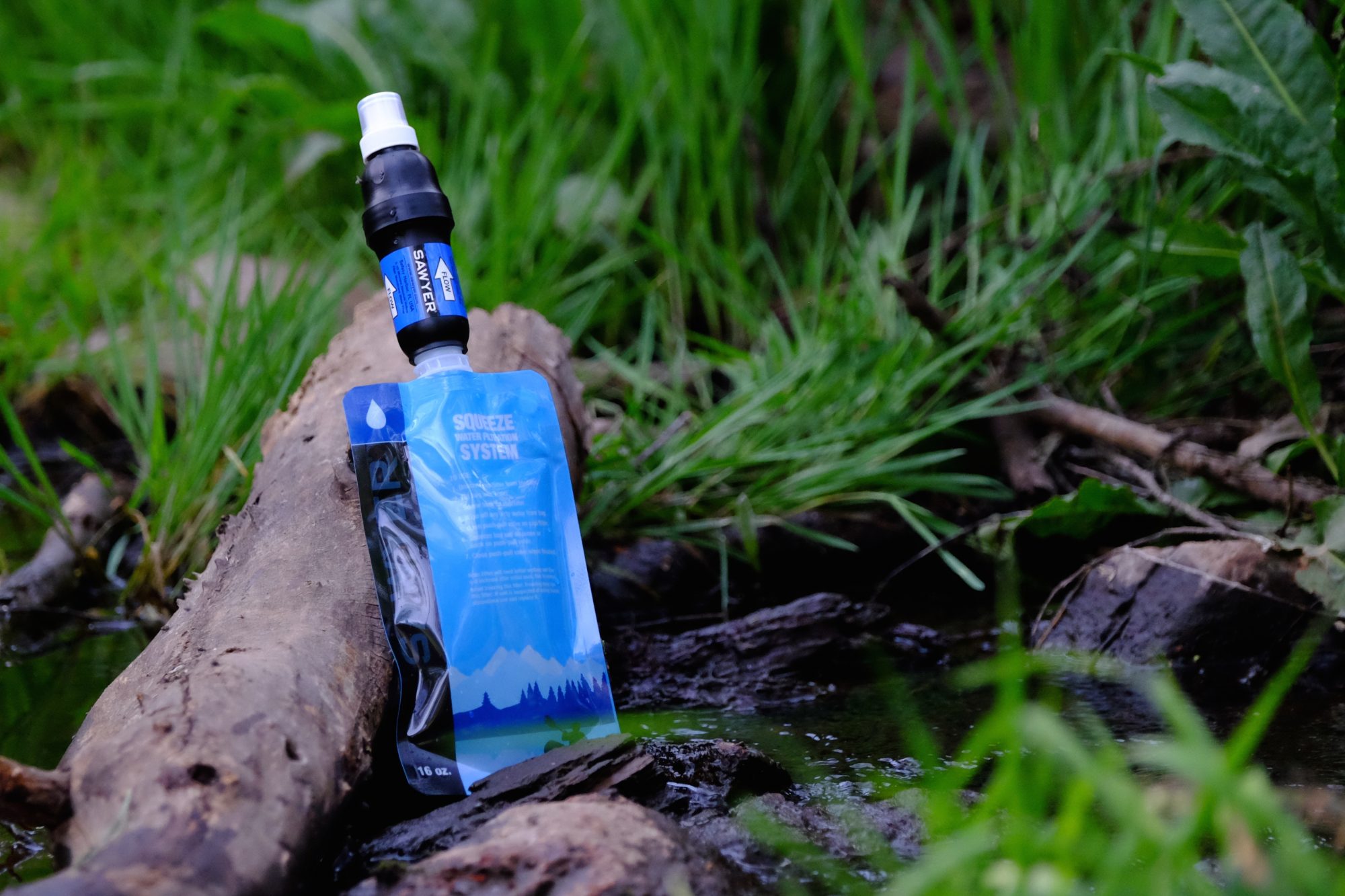
The Sawyer Squeeze system is a relative newcomer in the water treatment segment and in just a handful of years has become increasingly popular. The low retail price and lifetime warranty clearly added to its early success. At only 3.5 ounces the Squeeze, as tested in this roundup, came packaged with two 64-ounce and one 16-ounce soft bottles. The Sawyer filtration system is available in other products, but all employ hollow fiber technology to remove protozoa and bacteria, but not viruses.
Using the Squeeze is as simple as filling one of the three soft bottles, attaching the filter cartridge to the bottle threads, then squeezing the bag—hence the name. Then either drink from the top cap, or squirt the water into another container. The flow rate is a claimed liter per 30 seconds, but I’d put it closer to 60 seconds if not a tad more. Water turbidity is always a bit rough on hollow fiber filters and the Squeeze slows considerably when confronted with mild amounts of sediment, but the included syringe used to backflush the filter does a proficient job of restoring smooth water flow.
One nice perk of the Squeeze is the added versatility of the filter element. It can be used in-line on a hydration reservoir, or employed as a gravity fed filter, although in my tests it was pretty slow in that application.
Sawyer claims the hollow fiber filter element will last a lifetime of use with no need for replacement, but it’s important to note that no substantive tests have proven it to have an unlimited lifespan. I have no reason to doubt Sawyer’s claims, but just know it is possible to irreversibly clog any filter and that holds true for the Sawyer. Long-lasting does not mean infallible. For $50 including three soft bottles, it’s tough to beat the value of the Sawyer Squeeze.
Best attribute: Value and ease of use.
Ideal application: Emergency use, small group or individual backcountry travel, domestic use where viruses are of lesser concern.
Tester’s notes: Filling the bottles can often be a bit of a challenge. The small opening, tendency for the bottles to remain collapsed, and the shallow depth of some water sources create challenges. Not a big deal, but it can be frustrating.
Grayl Ultralight Purifier, $60
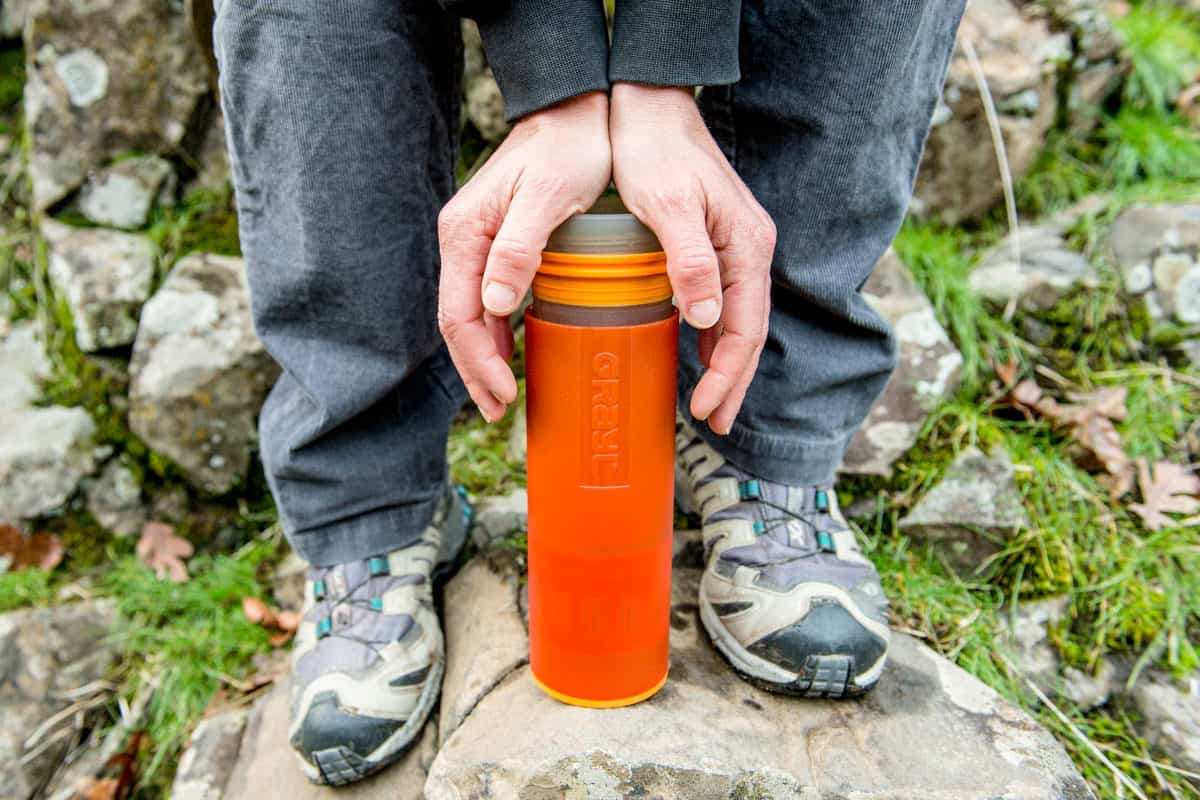
The Grayl first hit the market a few years ago and has become a popular solution for international travel and other personal use applications. The concept is very simple, and if you have ever used a French press to make coffee, you’ll be a quick convert to the Grayl system. Just fill the bottle with untreated water, insert the inner filter sleeve, press down, and drink away. Unlike many products in this category, the Grayl levies some bold claims. To pull some straight from their website:
“Unlike standard mechanical filtration, the Ultralight Purifier Bottle is powered by a patented electroadsorptive media capable of removing submicron pathogens and inorganic contaminants.”
Grayl says their filter can remove everything from bacteria and protozoa to viruses, chemicals, and even heavy metals. Those are indeed lofty assertions, but they also say they tested the filter performance using NFS/ANSI standards. I couldn’t find any additional third party certifications, but don’t want to elude to any false efficacy claims. Users of the Grayl system seem to be very pleased with the results. From my testing, which I will admit has been more limited than with other systems, I am inclined to believe this is a great option for international travel and day to day use where water quality is suspect. The filter does improve water flavor and it will remove everything including viruses.
There are some inherent limitations to the design. It can’t process large volumes of water so it’s not ideal for even small group use. It is best for scoop-and-drink scenarios and while it did well against water with high turbidity for a while, I was able to clog the filter quite significantly after just 20 liters. Eventually the force required to move water through the element became significant. Each filter cartridge can process up to 300 liters in the best scenarios, which is more than enough for most travelers. www.thegrayl.com
Best Attribute: Ease of use, convenience.
Ideal application: International and domestic travel. Daily use where water quality is suspect. Individual backcountry travel with abundant water resupply opportunities.
Tester’s additional notes: I’ll get lambasted for this, but I just don’t like this system. My filter clogged rather easily, required great force to filter even clear water, and just didn’t perform as well as other bottle filters.
Platypus Meta Bottle + Microfilter, $50
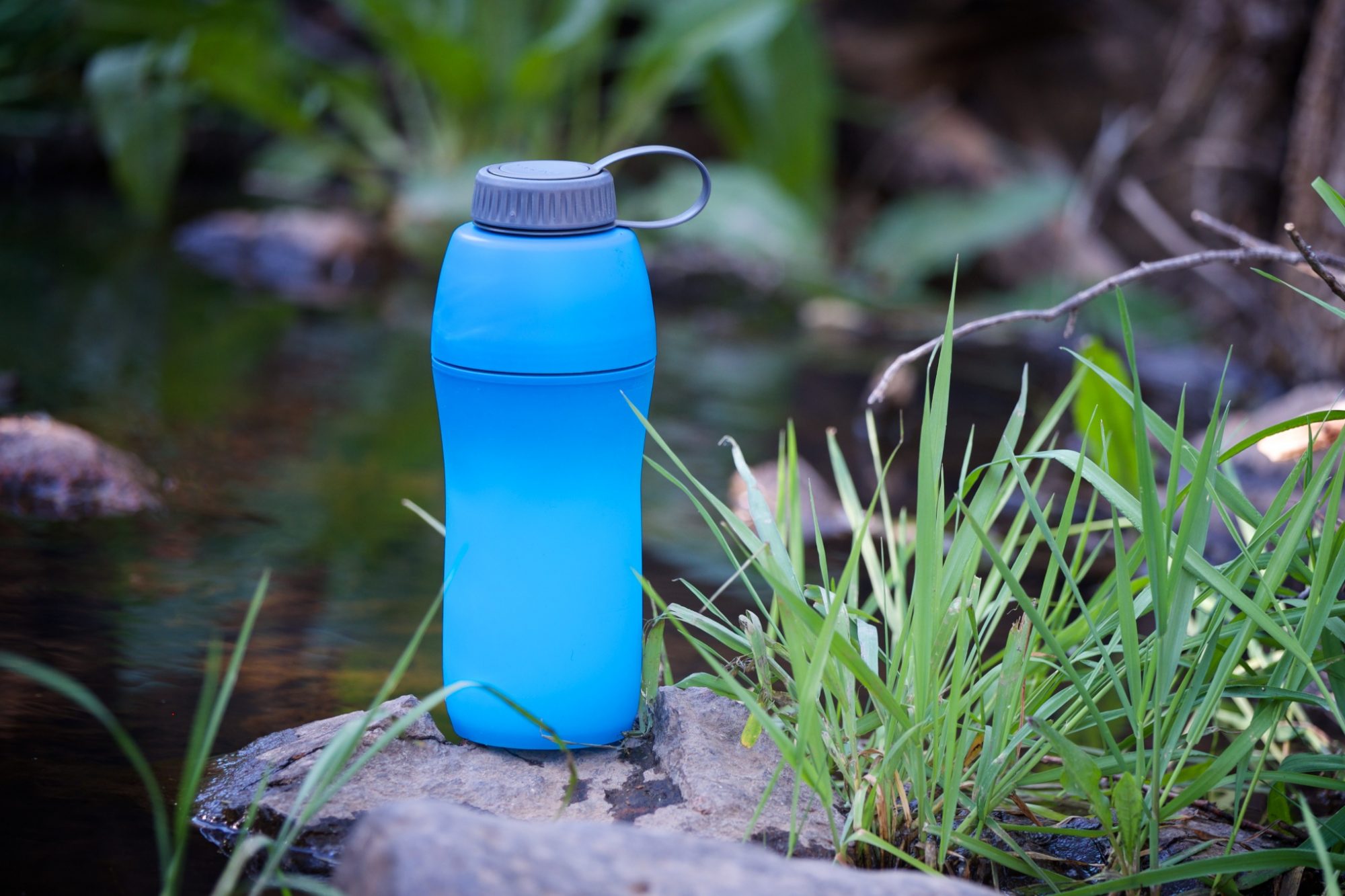
Another fresh entry in the personal filtration game is the Meta Bottle + Microfilter. Platypus has been in the soft-sided water container business for over 20 years and the Meta Bottle is their first foray into the almost traditional bottle market. Unlike other soft bottles, the Meta has enough structure to stand on its own and I find it easily slips into pockets and holders better than true soft-sided bottles. The hard top-cap includes a drink-through port with protective lid.
Filtering water is as easy as filling the lower half with untreated water, threading on the lid, and squeezing the bottle while drinking. Clean water is delivered at a brisk 2-liter per minute rate straight to your thirsty mouth. The filter uses the same MSR hollow-fiber microfilter technology which meets EPA and NFS standards to remove all the common biological pathogens with the exception of viruses. A single filter element can process up to 1,000 liters, and cleaning the microfilter requires little more than a few vigorous shakes. The Meta Bottle + Microfilter makes for an ideal travel or backup solution for personal use. www.platy.com
Best attribute: Simplicity and value.
Ideal application: Travel, solo backpacking in environments with frequent water resupply points, backup system.
Tester’s Notes: I’ve become rather fond of this system. I like the ability to remove the filter element when using it as a standard bottle for day to day use. My one quip is that it does leak just a touch if you handle it roughly or cram it into a backpack carelessly. Treat it nicely and it will do the same for you.
MSR AutoFlow Gravity Filter 4L, $120
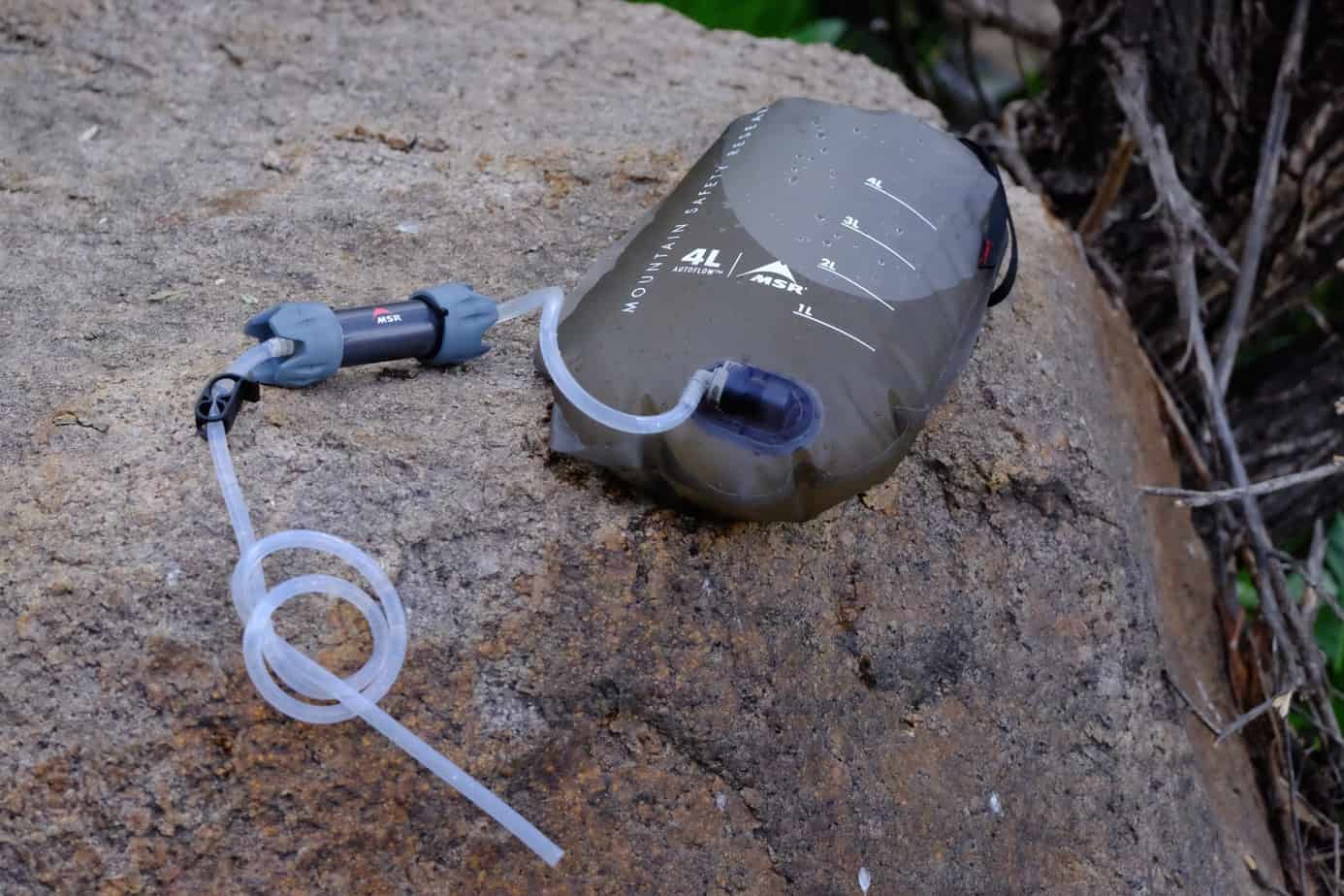
The AutoFlow has been around for several years and has been a system I’ve used since its inception. Great for processing large volumes of water with minimal effort, it’s also surprisingly quick at just under two liters per minute. Updated for 2017, the new AutoFlow utilizes the same reservoir material as used in their latest DromLite water bags, and now includes a high volume pre-filter located at the out-flow port. Exceptionally strong for the weight, the RF welded film is also easy to clean and packs small.
Using the Autoflow involves filling the reservoir with untreated water, hanging it on a tree limb, or rested on a boulder, then letting gravity flow water downward through MSR’s own hollow fiber filter. Backflushing the filter is as simple as reversing the flow by lifting the receiving container above the dirty water bag for a few seconds. In short, the backflush is as easy as the filtration process.
Classified as a micro-filter, the AutoFlow will not remove viruses, but it will remove all of the common bugs most travelers hope to avoid. With regard to the system’s ability to treat water with high levels of turbidity, I’ve found it does an admirable job of dealing with slightly murky water, but anything with substantial sediment is going to clog the hollow fiber straws in short order, and backflushing becomes necessary with increased frequency. If you’re desert dweller, it will be critical to decant your water before using the AutoFlow.
Fortunately, because the out-flow port is positioned above the bottom of the dirty water reservoir, you can decant your water in the bag. Just fill the reservoir, let the water settle for 15-30 minutes to give sediment a chance to drift to the bottom, then let the water flow through the filter element.
Best Attribute: Ease of use, portability.
Ideal Application: Small groups or situations where you will be required to process large volumes of water in a single session. Not ideal for processing small amounts of water multiple times per day as the setup does take a little bit of time. www.msrgear.com
Tester’s Notes: Simply put, I love this system for multi-day trips with lots of water filtering duties. When used within a group of 3-4 people, it has the ability to process big volumes of water with ease.
Platypus GravityWorks 2.0L Water Filter – Complete, $110

Because Platypus and MSR are both sold within the Cascade Designs family of products, there are many similarities between the AutoFlow and the GravityWorks as it pertains to technology and proficiency. The GravityWorks also uses a hollow-fiber filter to remove all common pathogens, save for viruses, and utilizes the same easy backflush procedure to keep things flowing smoothly.
Available in 4-liter and 2-liter sizes, both packaged with a well-labeled “dirty” water reservoir as well as a 2-liter “clean” water reservoir, both are made with Platypus’ indestructible material, which in 20 years I have yet to damage on even the most punishing outings. The Complete kit comes with additional bottle adapters for filling a variety of containers fitted with narrow and wide mouth openings. The hollow-fiber filter has a capacity of 1,500 liters and meets EPA and NSF guidelines for the safe removal of all common pathogens—viruses not included. www.platy.com
Best Attribute: Ease of use, portability.
Ideal Application: Small groups or situations where you will be required to process large volumes of water in a single session. Not ideal for processing small amounts of water multiple times per day as the setup does take a little bit of time.
Katadyn Base Camp Pro 10L, $100 (Best large group filter)
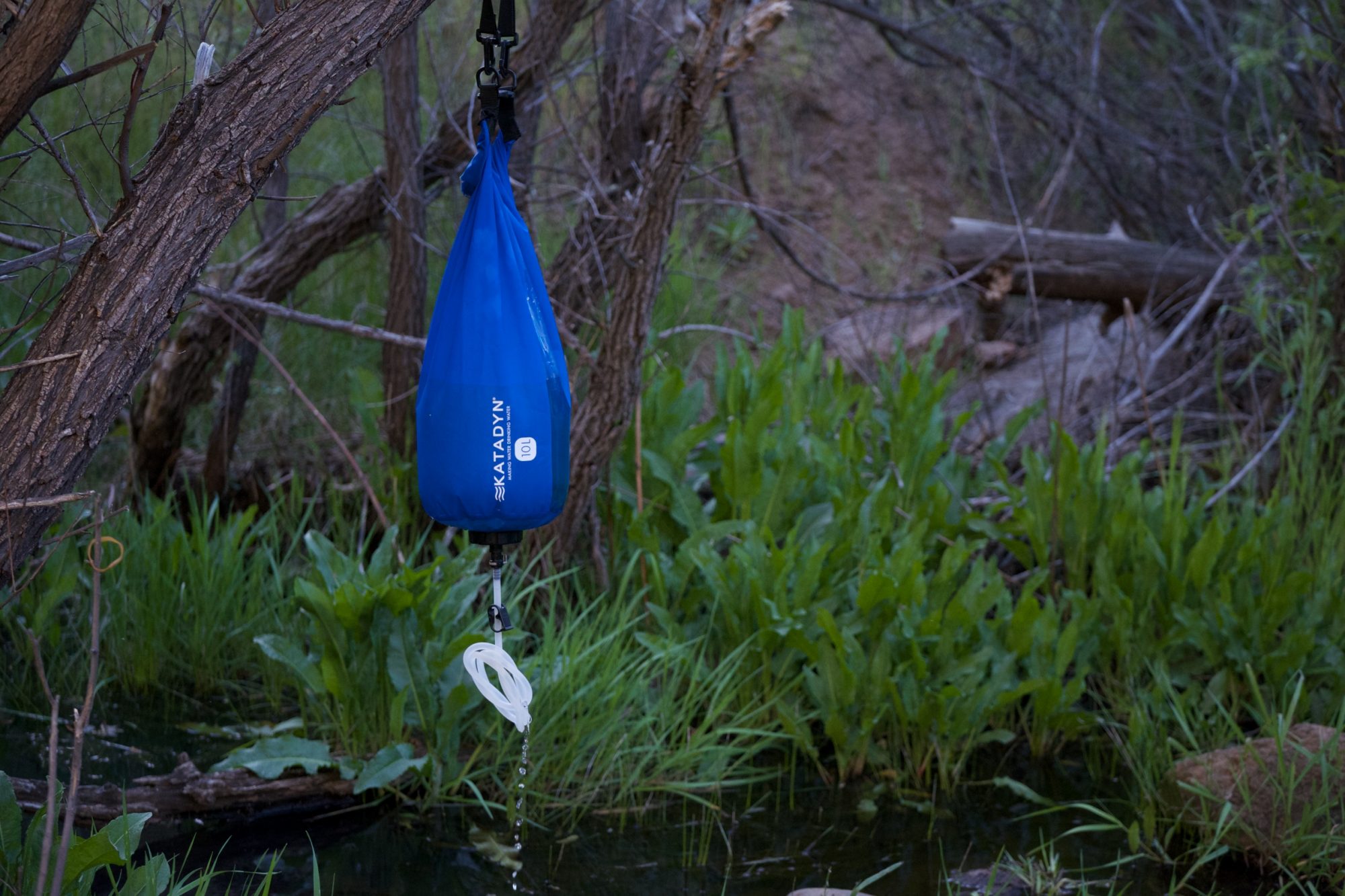
The largest of two gravity systems in the Katadyn lineup, the Base Camp is best suited for small to large groups requiring high volumes of clean water. To achieve that goal, every aspect of the system, including the massive 10-liter reservoir, was carefully engineered to be fast, reliable, and convenient.
Threaded within the base of the collapsable container is Katadyn’s own pleated glass-fiber Ultra Flow Filter protected by an outer pre-filter membrane. Backflushing filters is convenient but not always as effective as a proper scrub, and the outer membrane of the Base Camp filter can be removed, rinsed, and reinstalled in minutes returning the unit to its original two liter per minute flow rate. The fastest of any gravity filter on the market, it removes bacteria, protozoa, and particulates smaller than .2 microns. Helping to further reduce clogging, the filter element rests above a recessed sediment trap allowing dirty water decanting in the main bag prior to filtering.
Below the reservoir, a quick-connect attachment port permits direct filling to hydration reservoirs and accepts Katadyn’s optional shower attachment for maximum utility. Other convenient features include a large nylon strap for a comfortable carry and a transparent window to view water levels and inspect any sediment build-up on the filter membrane. Every aspect of the Base Camp was engineered to keep large quantities of water flowing regardless of turbidity, and after extensive tests with the unit pitted against grimy desert water, it proved it is up to the task. Katadyn claims they were the first to bring a gravity filtration system to market, and the Base Camp demonstrates their proficiency within the category. www.katadyn.com
Best attribute: Great for large volumes of water. Easy to clean making it ideal for turbid water.
Ideal application: Large groups in areas with murky water. Domestic use where viruses are not a concern.
Tester’s Notes: I was really blown away by this system. The technology behind the Base Camp is relatively old, but it is also extremely well proven. I kept loading the reservoir with increasingly silty goo and it kept clean water flowing. I wouldn’t hesitate to use it backpacking with a group of people, but it does pack larger than proper backpacking systems. For group travel where water turbidity is a problem, this is a great solution.
Dealing with sediment
There’s nothing worse than filtering your first of many liters of water and feeling your pump slowly fill with sediment and grind to a halt. No system is impervious to turbidity, but reducing its negative impact is quite easy. When faced with murky water, take time to decant it.
On virtually all of my trips I carry at least one Sea to Summit Ultra-Sil Kitchen Sink 10L. When I arrive at a water source, particularly one that is flowing but murky, the first thing I do is scoop up 10 liters of water and let it sit as long I as can. Even after as little as 15-30 minutes, cloudy water won’t look settled, but the amount of sediment dropped to the bottom of the container will make a huge difference when not forced through the pump. Just be sure to place the in-put hose at the very top of the water surface. I carry a wooden close pin for that task. The other advantage to decanting water is the fact I can collect my water, place it under a tree, and do my pumping business in the shade.
Wrap up
I’ll be the first to acknowledge this is not the entirety of water treatment options available today, but it represents the cream of the crop and the most trusted and technically advanced systems available.
With regard to the brands above, you’ll notice there isn’t a wide variety of names in this industry. This stems from a few developments over the years. Names like SweetWater and PUR were merged with Cascade Designs and Katadyn respectively. Some of you old-timers may wonder where the First Need filter is in the list. While not a bad unit, it was pushing obsolescence 20 years ago, so it’s not a very popular option these days. Proficient as a purifier, it’s heavy, bulky and just not up to date.
With the exception of the Potable Aqua, and perhaps the Grayl, I’d wholly recommend any of the systems on this list. Which one is best is relative to your individual needs. And after two years of filtering and drink ing some of the nastiest water in the West…I’m ready for a beer. – Christophe Noel


